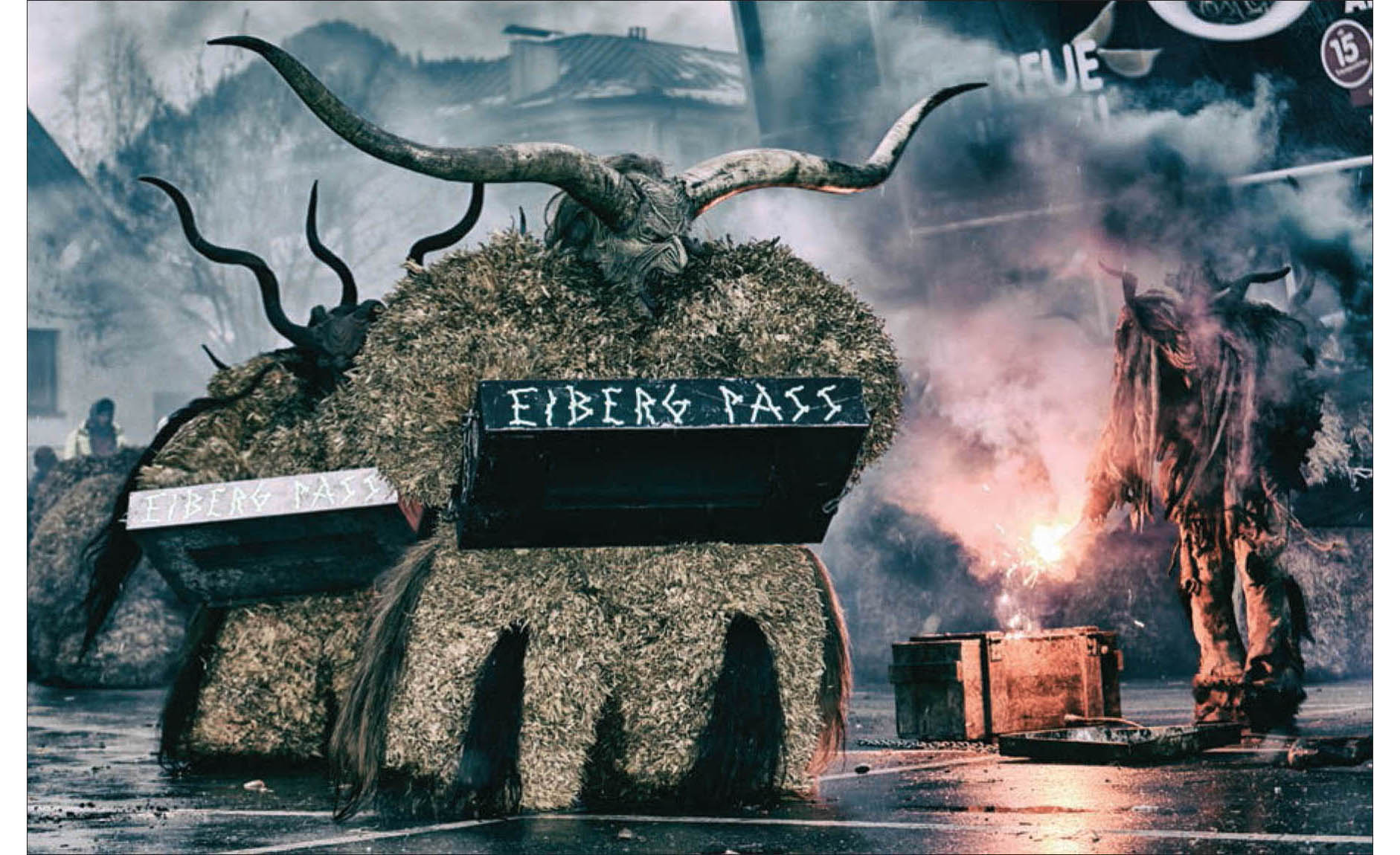

Percht nicknamed “Baumschwammerl” (“Mushroom”) at Perchtenlauf, Kirchseeon, Germany. Photo ©Manfred Kornherr.


Tyrolean Unterland-style Perchten from Eiber Pass, Schwoich, Austria. Photo ©Martin Guggenberger Photography (2015).
Perchten in the Tyrolean Unterland
A Perchten tradition worth mentioning not for its antiquity but for its unique style is that of the Tyrolean Unterland, along the Lower Inn Valley in the district of Kufstein. Perchten there are outfitted in immense, voluminous suits made of cornhusks.
In this region with no deep-rooted Perchten customs, the style seems to have evolved over the last few decades, beginning in Breitenbach am Inn, and spreading to other nearby towns, notably Wörgl, and Angerberg. To what extent the suits may have been inspired by earlier, similar uses of straw is unknown, but there are plenty of precedents, dating back to 1522 with Luther’s reference to “fraw Hulda,” costumed in “straw armor.”
Work on the suits, which are made anew every year, begins as early as August with the husking of corn. Husks are stitched into bundles, combed over nails set in a board to make them bushier, then sewn over old clothes. Up to 1000 bundles are needed to make a single suit, which can weigh well over 200 pounds. Even more daunting is the fact that the husks aren’t always plentiful on local farms, so troupes have been known to drive as far away as Northern Italy to obtain them. Though the local term for Perchten is “Peaschtln,” and this word is often used, the figures are also sometimes called Bratschinger from the word for cornhusk (Bratschen). The Bratschinger wear more traditional masks usually topped by particularly long and impressive horns, either resin replicas or real specimens from the African kudu.
The Unterland Perchten wear not only the usual bells but also produce an impressive din with synchronized drumming on old gas tanks carried on chains hung over the shoulders. Each troupe composes a distinct rhythm by which it is recognized. Sometimes the tanks are even rigged to spew evil-looking smoke when played. Discordant horns contrived from old car horns also contribute to the cacophony. Each member of the troupe is identified by his role in raising this hellish din, either being a Damperer (drummer), Glockinger (bell ringer), or Bläser (horn-blower).
While the Bratschinger handle the noisemaking, they are not the only type of Percht in the troupes. They are accompanied by the Fellteufeln (“fur devils”) costumed, as the name suggests, in the traditional animal hides. Infinitely more mobile than their corn-clad cousins, the Fellteufeln are also called “runners” (Läufer). The leader of the troupe is the Witch, played by a man dressed in black rags and with face blackened.
To begin a performance the Witch prepares a fire in a cauldron in a central area. For this reason the Perchten events here are less mobile, and processions tend to revolve around this staging area. The fire is usually rather smoky by design, and throughout the performance, the Witch will often enhance the infernal miasma with smoke bombs or other pyrotechnics.
The ritual begins with the Bratschinger entering and forming a circle around the cauldron, beating their tanks as accompaniment to the Witch. Throughout her routine, she uses her broom to symbolically sweep evil spirits inward toward the central fire where they will be destroyed. The Fellteufeln assist in the sorcery by circulating outside the drummers’ circle, searching out additional troublesome demons and wrangling them inward. Though only decades old, this spectacle, with its monstrously oversized Perchten, soot-black witch, thundering gas-can percussion, and ample use of fire and smoke, does more perhaps than any to conjure for the modern imagination the notion of a supernatural battle with infernal forces.

History
With centuries-old roots deeply intertwined with the Krampus tradition, the Gastein Perchtenlauf, founded in 1898, is the oldest and best known in the world, and in 2011 became an Austrian addition to UNESCO’s list for Intangible Cultural Heritage. The Gastein event takes place every four years (most recently in 2014) on Epiphany Day and on the Sunday preceding. The 9-hour procession visiting Bad Gastein, Bad Hofgastein, and farms and homes in outlying regions covers approximately 10 miles with different routes both days. On years the event is not held in Gastein, the nearby Pongau towns of Altenmarkt, St. Johann, and Bischofshofen alternate hosting duties, with the entire four-year cycle sometimes referred to as the “Great Pongau Perchtenlauf.” The parade in Bischofshofen dates to 1912, St. Johann to 1952, and Altenmarkt to 1959. While the Gastein’s Perchtenlauf is first documented in its current form in 1898, less organized forms of Perchten activity in the Pongau occurred long before this.